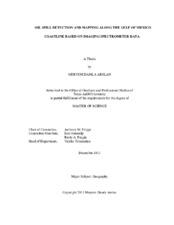| dc.description.abstract | The Deepwater Horizon oil spill in the Gulf of Mexico between April and July 2010 demonstrated the importance of synoptic oil-spill monitoring in coastal environments via remote-sensing methods. This study focuses on terrestrial oil-spill detection based on hyperspectral images acquired along the coastline of the Gulf of Mexico. A number of AVIRIS (Airborne Visible/Infrared Imaging Spectrometer) imaging spectrometer images were investigated in this research collected over Bay Jimmy and Wilkinson Bay within Barataria Bay, Louisiana, USA during September 2010.
Various remote-sensing image processing techniques were employed to detect/identify oiled vegetation. Image-derived endmembers were extracted from the atmospherically- and geometrically-corrected hyperspectral AVIRIS data via Minimum Noise Fraction transform, Pixel Purity Index generation, and n-dimensional visualization. Extracted endmembers are then used as input to endmember-mapping algorithms Spectral Information Divergence (SID) and Mixture Tuned Matched Filtering (MTMF) to yield fractional-abundance images and crisp classification images. Field based observations of the degree of oil accumulation along the coastline were also employed, as well as in situ measurements from the literature.
Multiple Endmember Spectral Mixture Analysis (MESMA) was employed for oiled-vegetation detection and mapping in order to enable the number and types of endmembers to vary on a per-pixel basis, in contrast to simple Spectral Mixture Analysis (SMA). MESMA thus better allows accounting for spectral variability of oil (e.g., due to varying oil thicknesses, states of degradation, and the presence of different oil types, etc.) and other materials, including soils and salt marsh vegetation of varying types, which may or may not be affected by the oil spill. The classification results demonstrated that MESMA provides advantageous capabilities for mapping several oiled-vegetation classes along the Gulf of Mexico coastline, relative to the conventional approaches tested. | en |


